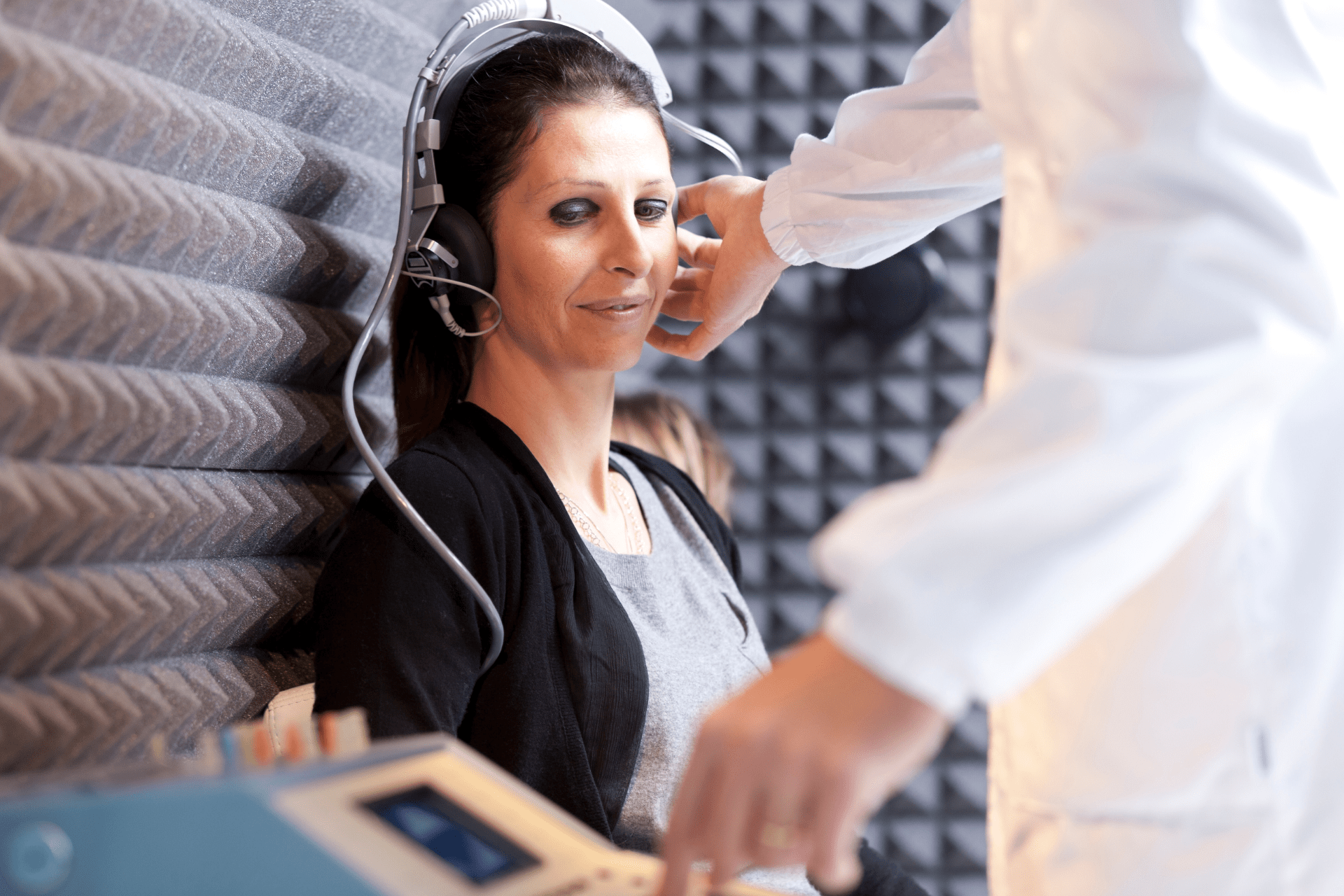Did you know that there is more than one hearing test? Each of them use different techniques to measure your ability to hear. In today’s article, we will dive into every hearing test available to you, and how they are performed.
Pure tone audiometry
Kicking off our complete hearing test guide is a pure tone audiometry test. Now, a PTA is one of the most common and fundamental hearing tests; it’s used to measure an individual’s hearing across a range of frequencies. It can help identify the type of hearing loss you may have, it can quantify the extent of your hearing impairment, and determine the softest, or threshold sounds that a person can hear at different frequencies (typically ranging from 250 Hz to 8000 Hz). These results are crucial for prescribing and programming hearing aids, as they inform audiologists about the individual’s specific hearing needs.
During the test, you will be seated in a soundproof or sound-isolated room to eliminate noise interference. You will wear headphones which are connected to an audiometer, which is a piece of equipment used to produce pure tones at various frequencies. When a sound is played, you will press a button or raise your hand. The results are then plotted on an audiogram, a graph that shows the threshold levels for each ear at different frequencies.
Speech audiometry
The next type of hearing test on our list is a speech audiometry test. This test will evaluate your ability to understand and process speech sounds. The procedure is similar to a pure tone audiometry test; you will be seated in a soundproof room or a quiet environment wearing headphones. Then, the audiologist will present recorded speech signals (often two-syllable words with equal stress on each syllable) at a range of intensity levels. The patient will then be asked to repeat the words or respond when they hear them.
Once completed, the results are calculated as a percentage of words correctly identified out of the total words presented. It gives the audiologist a good indication of where your hearing ability is at and determines what kind of treatment you may need.

Tympanometry testing
Two down, six to go. Another type of hearing test is tympanometry testing. What is it? well, it is a diagnostic test used to assess the function and health of the middle ear, specifically the eardrum and the middle ear. It is a valuable tool and can provide important information about various ear conditions in this area, such as otitis media. Once you’ve undergone testing, the results are typically interpreted based on the shape and position of the tympanogram, which can be categorised into several types; type A, B,C, Type As, and Type Ad.
This provides valuable information to your audiologist as they can diagnose your middle ear issue and provide a suitable solution. One solution could be hearing aids orinn some cases, ventilation tubes.
Otoacoustic emissions testing
Otoacoustic emissions testing is next on our list. This hearing assessment is used to evaluate the function of the inner ear and it measures the sounds emitted by the cochlea (inner ear). Vibrations are given off by the inner ear when responding to a sound. The vibration creates a quiet sound that echoes back into the middle ear. It can also show if there is any blockage within the outer and inner ear. If there is a blockage, zero sounds will be able to get through to the inner ear, which means no vibration or sounds will come back.
Auditory brainstem response testing
Auditory brainstem response testing (ABR) is used for children or others who can’t complete a typical hearing test screening. You will have electrodes put on your head; which will record brain wave activity in response to sounds you hear through earphones. During the test, you have to be quiet so the readings are accurate.
ABR testing can also be done on babies to see if they’re hearing is good or not!

Auditory steady-state response testing
Auditory steady-state response (ASSR) testing, is where the brain will be measured to conscientious sounds at specific frequencies. It allows an audiologist to create audiograms for those who are unable to participate in behavioural tests. It’s similar to ABR testing; they both record brain activity through electrodes. But there is a key difference between them. ASSR uses phrases instead of sounds to measure brain activity.
Tinnitus test
The next test on our list is a tinnitus test. The test determines the pitch and loudness of a person’s ringing in the ear. During the procedure, you will sit in a soundproof room wearing earphones, and you will be asked to indicate whether you can hear any ringing noises or not. The audiologist will assess whether you have tinnitus or not, and if you do, they will be able to determine the severity of it. Don’t be too worried if you have tinnitus as there are many treatment options available for you. The quicker you can identify it, the quicker you can be treated for it.
At Sutton Hearing Centre, we offer tinnitus counselling to people experiencing ringing, humming or buzzing sounds. Our professional audiologists can help you manage it.
Central auditory processing disorder testing
The final hearing test on our list is a central auditory processing disorder (APD) test. The test is common for children, and it assesses how their brain processes auditory information. Typical APD symptoms include struggling to understand people speaking in noisy places, similar sounding words, instructions, or people with strong accents/fast talking. If you’re experiencing any of these issues then you will need an APD test. Throughout the test, you or the child will be asked to listen to a variety of signals and respond to them via repetition or by pushing a button.

Now, that was a lot of technical information to take in, so don’t worry if it hasn’t sunk in yet. If you have any questions about the hearing tests we’ve mentioned above, then get in touch with our team to learn more.
Alternatively, if you’re struggling with your hearing and think you need a hearing test, then get in touch with our audiologists today and book an appointment.

